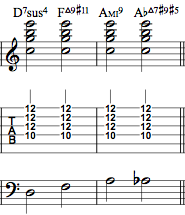As a guitarist, it is easy to fall into the rut of using the same chord voicing each time over a set of changes in a tune. With all the complexities the fret board offers us, it can take awhile to recall certain shapes that we want to grow accustomed to using over time; although I’m not one to teach harmony by solely relying on shapes since it hinders learning about theory and voice leading.
Moreover, it can take months and years to feel secure playing a new voicing organically. However, what if I were to tell you that you could use a voicing that you already know over a different bass note? This is a very effective way to use one voicing that you’ve mastered in another context. After all, sometimes it does work better to have as many usages for one voicing than to know a bunch of chords and never make the connection that they could be used as a different function. The voicing could be used as a consonance or a dissonance—more on this later. Furthermore, it will take less time than learning a bunch of new chords since you will be playing the ones you already know. You’ll just think of them in a different context. That, and when you do apply that new special voicing, you’ll have many others to choose from at the next gig.
Let’s begin by examining a standard CMajor7 voicing that many of us know in Ex. 1:
If we look at each chord tone as it relates to the chord written on top, the c functions as the root, the g functions as the 5th, the b functions as the 7th, and the e functions as the 3rd of the chord. However, if we start changing the bass note, the function of the chord will change. In Ex. 2, I’ll keep the same four notes, but will change the notes in the bass clef. You can experiment with recording all 12 bass notes in the chromatic scale and playing a specific voicing through each bass note. Some will work better than others and some won’t really work well at all, but you may come up with a sound that may not look great in theory, but will sound unique. With this particular voicing, I found it works well over four different bass notes. Check out Ex. 2:
As you can see, each chord from Ex. 2 has a different function. Here’s the run down:
1.) D7sus4: The c functions as the 7th, the g functions as the 4th, the b functions as the 13th, and the e functions as the 9th of the chord.
2.) FMajor7(#11): The c functions as the 5th, the g functions as the 9th, the b functions as the #11th, and the e functions as the 7th. Notice the 3rd of the chord, a, isn’t present. You don’t necessarily need to play the basic chord tones (3rd and 7th) each time. It depends on how specific you need to define each chord. Sometimes, the 3rd or 7th will be in another part, such as the melody.
3.) Aminor9: The c functions as the 3rd, the g functions as the 7th, the b functions as the 9th, and the e functions as the 5th. This is a consonant function.
4.) AbMajor7(#9#5): The c functions as the 3rd, the g functions as the 7th, the b functions as the #9th, and the e functions as the #5th. This chord is a bit more modern in use and more dissonant in function because of the major 3rd and minor 3rd—c (3rd) and b (#9) as well as the #5th (e). Usually, you would expect this chord to have a dominant 7th quality, but the major 7th quality will yield interesting sounds too.
What really makes this concept effective is learning all the inversions for the voicing type on each of your string groups—both in higher and lower registers. Check out Ex. 3 to what the CMajor7 voicing looks like with all the possible inversions on the 5th string group:
Once you learn all the inversions, try making the voicing more spread out or closer together. Also, create a schedule to learn all the major 7th chords and their inversions in all 12 keys. You’ll see eventually that you can travel a lot of miles out of knowing the one voice type and its inversions. Then, you can try it with the minor 7th voicing, dominant 7th voicing, and so on. To apply this concept, you could vamp the four different chords and bass notes in Ex. 2 and play the CMajor7th voicing over them. Then you can take this process and apply it to something you discover on your own. Patience is key as well as practicing one thing at a time. However in the long run, you’ll be able to use one voicing in multiple contexts.


